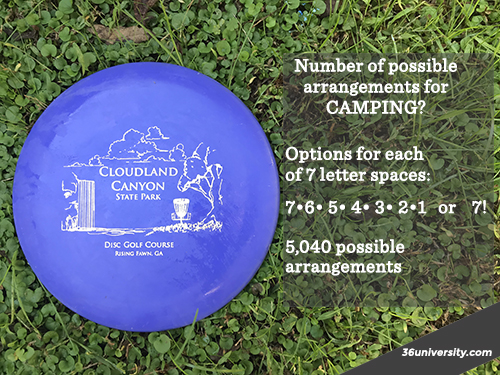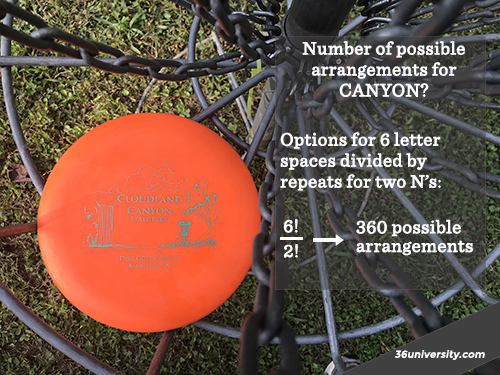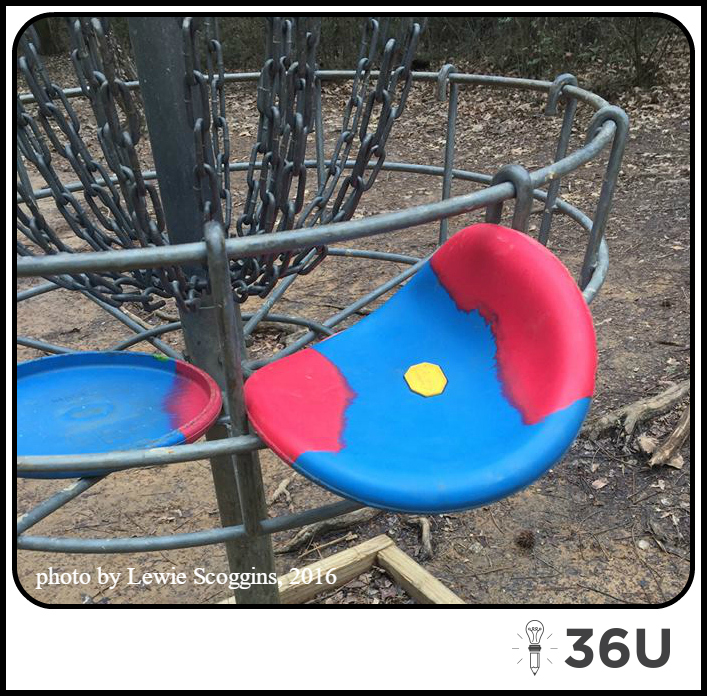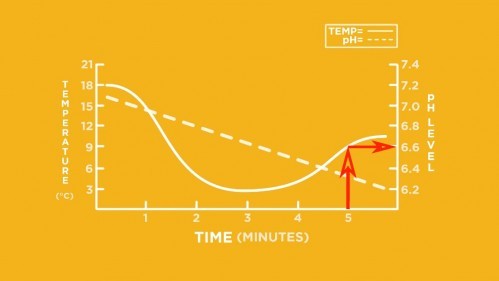New ACT Math Test Content Part 1: The Factorial
Combinatorics has been added to the ACT math test—and 36U is here to get you ready!
Don’t worry. Combinatorics may sound intimidating, but it’s really about fancy, advanced counting techniques that can be a lot of fun and save lots of time. Let’s get right to it.

Factorials
First, let’s work on a possibly new concept with some new notation—the factorial.
6 factorial, written 6!, means 6 • 5 • 4 • 3 • 2 • 1.
And, again:
5! = 5 • 4 • 3 • 2 • 1
To simplify, 5! = 5 • 4 • 3 • 2 • 1 = 120.
 Let’s put the factorial to work…
Let’s put the factorial to work…
Example 1: In how many different ways can you arrange the letters of the word OVERCAST?
____ ____ ____ ____ ____ ____ ____ ____
You have 8 options for the first letter, 7 options for the 2nd, 6 options for the 3rd, and so on.
Mathematically, that looks like this:
_8 options •_7 options •_6 options •_5 options •_4 options •_3 options •_2 options •_1 option
or
8! –> 40,320
There are 40,320 different ways the letters of OVERCAST can be arranged.
Easy so far. Let’s move on…
 Example 2: In how many different ways can you arrange the letters of the word CANYON?
Example 2: In how many different ways can you arrange the letters of the word CANYON?
This is a slightly trickier item because CANYON has 2 N’s! Fortunately, if you understood our first example, this isn’t much more difficult.
Step 1: There are six different spots to place the letters in the word CANYON:
_6 options •_5 options •_4 options •_3 options •_2 options •_1 option = 6!
There are 6! or 720 different ways of arranging C-A-N-Y-O-N, but…You have to account for repeated options because there are 2 Ns. Here’s how:
Take your total number of possible arrangements (6!) and divide by 2! to account for N appearing twice.
6!/2! –> (6 • 5 • 4 • 3 • 2 • 1)/(2 • 1)
–> 360
There are 360 different ways the letters of the word CANYON can be arranged!
That’s your introduction to new counting techniques (combinatorics) that are being tested on the ACT.
Take time to brush up on your combination and permutations, too. For more instruction and practice on these topics, check out our online program.
-Dr. Kendal Shipley, 36U
10/13/17
Get a Copy of Your ACT and Fix the Mistakes!
Imagine retaking a test without knowing what you missed the first time. Unfortunately, that’s how too many students operate on the ACT. It doesn’t have to be that way!

Buy a Copy of the Test You Took
Did you know that ACT allows you to purchase a copy of the questions from your exam, a list of your answers, and the answer key? ACT calls it Test Information Release, and it costs $20. The option is available for only certain dates, but both the April and June ACT administrations —4/8/17 and 6/10/17—are Test Information Release dates. If you took the optional writing test, ACT will also include the writing prompt, the scoring rubric, and the scores you received on your essay.
Is It Too Late for Me?
If you have already taken an ACT and didn’t purchase the Test Information Release, ACT gives three months after the test date to order the test. So, if you took the April 8, 2017 ACT, it’s not too late for you to get a copy of your exam! To order, you’ll need to fill out the Test Information Release Order Form.
Final Word
Your quarterback keeps missing the post pattern? Coach is likely to have him throw several during practice. Your lead chair clarinet keeps missing a difficult section in the latest musical piece? She is likely to practice the piece again and again until she gets it. What better way is there to begin improving your ACT score than to work through the problems you missed? Take it one step further: make a list of topics that are difficult for you and review those concepts until you master them.
Are you interested in skill-targeting ACT Prep? Check out the service at 36U!
Recent & Related Posts:
The Juggling Act Required by the ACT English Test
3 Types of Probability Items to Expect on the ACT Math Test
Origami: Sharpen Visual-Spatial Skills & Boost Your ACT Math Score
36U Blog List
36U ACT Tips
36U ACT Prep Program
Your Week-Before-the-ACT Game Plan (Part 4 of 4: Science)
This is the final installment of our week-before-the-ACT game plan. Let us know how your game plan works on the big test!

The Setup
It’s nice to finish off the ACT with another shorter test. The Science Test, like the preceding Reading Test, will give you 40 minutes to answer 35 items. Those 35 items will be spread over 6 to 7 scenarios.
The Tables Have So Many Rows and Columns
Do you need to be reminded how complicated ACT Science tables can get? ACT is an expert at packing a ton of info into a single table. And the more information they put in a table, the more confusing and intimidating the table is likely to be.
Use one simple principle to read the tables efficiently: the first column almost always tells you WHO the table is about, and the rest of the columns tell you WHAT they are going to tell you about the WHO. Take the table below, for instance. The table is about different months. For each of those months, the table gives you the temperature, the pH, and the dissolved oxygen reading. This principle works no matter how difficult the table becomes.

And The Graphs Have So Many Plots and So Many Axes
Do they have to display so many relationships on a single graph? Along with multiple graphed relationships, you are often given multiple x- and y-axes. Yes, the graphs can get complicated in a hurry. Your ability to locate relevant information and interpret it will be crucial. Follow these two steps to simplify the process:
- Use the key to figure out which graph corresponds with which axis. In the graph below, you see the solid temperature graph corresponds with the axis on the left, and the dashed pH graph corresponds with the axis at the right.
- Be prepared to trace lines to find specific values. Can you find the pH level at the 5-minute mark? Start at the 5-minute mark and draw a line up to the solid pH line. From there, trace right to the pH axis. The pH is about 6.6.

What About the Text-Only Passage?
The Conflicting Viewpoints scenario will be the only scenario comprised of only text. Several viewpoints will be presented. As you read the viewpoints, underline key details from each, making sure to note how they differ. You will be asked to differentiate between the perspectives.
A Game Plan
Read the introductory text of each scenario carefully. The text is used to explain the setting of the research or experiments. Understanding the setting is often critical to interpreting the tables and graphs correctly.
For each table, identify WHO the table is about and WHAT they are going to tell you about the WHOs. For graphs, note the input axis label (horizontal axis) and the output axis label (vertical axis) and check to see if there is a key. You will not likely need to spend any significant time reading the tables and graphs before you get to the questions. Use the questions to tell you where to focus on the tables and graphs.
Many of the more difficult items will require you to synthesize information from several pieces of the scenario. Information found in the text may be key to understanding a table. Data from two graphs may be required to answer a single item. Many times, these difficult items are found in the final few questions of a scenario.
Recent Posts:
Your Week-Before-the-ACT Game Plan (Part 3 of 4: Reading)
Your Week-Before-the-ACT Game Plan (Part 2 of 4: Math)
Your Week-Before-the-ACT Game Plan (Part 1 of 4: English)
Your Week-Before-the-ACT Game Plan (Part 3 of 4: Reading)

This is the 3rd part in our 4-part series on finalizing your game plan the week before the ACT. It’s time to put a game plan in place for the Reading Test.
The Setup
There is no mystery here: you’ll have 35 minutes to answer 40 items. The 40 questions will be evenly divided over 4 passages. Each passage is fairly lengthy – almost 750 words (a little shorter than this blog post). Oh yeah, don’t forget that one of the passages will likely have two separate texts. That’s a relatively new twist. The first 6 or 7 items on the “double text” passage will ask you about the passages separately. The last few will ask you to evaluate relationships between the passages. If you want to give a double text passage a try, click here.
Start with the Questions or the Passage?
Some students insist on reading the questions before they head to the text. Some of these students even go so far as scavenging through the passage looking for answers rather than reading it. Students who use this approach often have difficulty perceiving big picture concepts like main idea or author’s purpose, and we know those questions will be asked. Students who have taken several ACT Reading tests should have a pretty good idea of the types of questions they ask already (more on this shortly). Other than knowing which details are targeted in the questions, there isn’t much to gain by reading the questions first. I suggest starting with the passage, reading slowly enough to remember details and at the same time looking to piece together the big picture.
Even students who read the passage often read it so hurriedly they miss key information. Either the average student reads almost twice as quickly as I do (in my experience, they usually get to the questions in about 2 minutes and it takes me about 4), or they aren’t reading carefully enough. Speeding through the passage in order to start the questions ends up costing students time because they find themselves having to reread a large portion of the passage to find answers. I find if I take my time reading the passage, making sure I understand the text, then I can run through the questions quickly enough to stay on pace.
The Passages Change; The Questions Stay the Same
As I mentioned earlier, we know what questions they are going to ask. Sounds rather bold, right? It’s not, really. Reading comprehension means essentially the same thing whether you’re reading an ACT passage or the sports page or Moby Dick. Skilled readers are able to visualize and remember details while staying sensitive to a passage’s purpose and tone. The ACT’s questions are going to test how well you remember those details and how well you comprehend purpose and tone, too.
So, here’s what you can expect from each set of 10 items. There will be several questions based on what is explicitly stated in the text. Usually these answers can be found in a particular sentence or two within the passage. We call these Level 1 items. Level 2 items will ask you to read between the lines to figure out what the author meant. These answers will usually be found in a specific area of the text. You may have to reread a few sentences. And the most difficult items will test your understanding of the passage on a larger scale: Why is the purpose of the 3rd paragraph? What is the main idea of the passage? We call these Level 3 items. These are precisely the types of questions that may give you trouble if you choose the scavenger hunt approach.
A Game Plan
My game plan for attacking the ACT Reading is something like this:
Though the passages seem lengthy, this is one of the ACT’s shorter sections. There are only 40 items, and it will be over in 35 minutes. That’s good, because it won’t leave me mentally drained. Stay calm and confident. Keep a steady, moderate pace. Read the passages carefully, underlining details that seem important. Details will help me answer Level 1 and Level 2 questions. At the same time, prepare for Level 3 items by observing the structure of the passage and noting the writer’s perspective and purpose. On average, I have a little less than 9 minutes per section. From previous practice, I know I can comfortably read through most passages in about 4 minutes, leaving me about 5 minutes for the questions.
If your approach is radically different than mine, now is probably not the time to change it up. Write out your own game plan, one that matches what you have already practiced. At the end of the day, you want to be confident your approach gives you the best opportunity to make your best score.
Recent Posts:
Your Week-Before-the-ACT Game Plan (Part 2 of 4: Math)
Your Week-Before-the-ACT Game Plan (Part 1 of 4: English)
Your Week-Before-the-ACT Game Plan (Part 2 of 4: Math)

This week, we’re helping you put the finishing touches on ACT prep before the big test. Sports teams wrap up practices and perform walk-throughs to rehearse the game plan and let their bodies recover. We want to help you wrap up your ACT prep, rehearse your game plan, and ensure your mind is at its peak for this weekend. Yesterday, we reviewed our game plan for the ACT English section. If you missed it you can find it here. Now on to the Math Test…
The Setup
For the Math Test, you’ll be given 60 minutes to work 60 items. Consider this good news because 1) it makes time-keeping super easy, and 2) this is more time per item than you will be given on any other section.
All Those Topics?!?!
The difficulty with preparing for the Math Test is that there are SO MANY concepts that can be tested. On the English Test, you will be tested on grammar, punctuation, and structure, but there are limited variations within each of these topics. On the Reading Test, expect to encounter six different question types at differing levels of difficulty. On the Science Test, you’ll need to be able to evaluate experiments, research, and theories while pulling data from tables and graphs. While algebra may sound innocuous, there are a multitude of algebra concepts. Similarly, geometry and trig can be tested in many ways from many angles. This is where paying attention in class and a quality ACT prep program really pay off.
All Those Words?!?!
To make things even more difficult, ACT feels compelled to make math items wordy—very wordy. Many of the items will come in paragraph form. Save time by realizing the question is almost always at the end of the paragraph. If you are comfortable, start there so you will know what info you need to find. Sometimes, all the info you need will be found in the accompanying picture. The most vital part of the text is usually the numbers and equations. Plucking this info from the text may allow you to avoid reading unnecessary information.
Not All Items are Created Equal
Even though you are given one minute per item, most of them shouldn’t take a full minute to work. On easy problems, don’t second guess yourself to the point of wasting time. A 10-second item should stay a 10-second item. You’re putting time in the bank to use on that crazy, out-of-left-field logic problem you’ll encounter later on the exam.
A Game Plan
After that description, the Math section may sound intimidating, but it doesn’t have to be overwhelming. Create a game plan that caters to your strengths and style. My own game plan sounds something like this:
Sixty minutes is plenty of time. I’ll need to keep a good pace and save time on easier items so I can spend more time on more difficult items that tend to show up at the end of the test. I am confident in my Algebra skills: solving equations, solving inequalities, evaluating graphs, and so on. My geometry skills should be up to the challenge, too. I know I’ll need to work with angles within polygons and circles. I expect at least a right triangle or two. I’ve brushed up on my Probability and Stats. (ACT said they would be testing this a little more often.) To ensure I’m ready to make a top score, I’ve reviewed my trig, too. Make sure to finish the test! Leaving items blank just leaves points on the table.
Now it’s your turn! Print a Math Test and walk your way through it. (You can find a recently released exam in ACT’s Preparing-for-the-ACT Guide.) Recite your own game plan for the Math section. Take your time to scan the items—not necessarily working them—to see how well your game plan works. You’ll get even more value if you’re willing to put a check mark by each item you’re pretty confident you can work. At the end, count up your check marks and score your test by using the scoring chart at the end of the manual. Having a good feel for where you will end up will help you perform to your ability this weekend!
Your Week-Before-the-ACT Game Plan (Part 1 of 4: English)

Sports Teams Do This; You Should, Too!
Football teams that compete at a high level review hours of their opponent’s game film. Similarly, you’ve already reviewed frequently-tested ACT topics. Teams spend hours implementing a game plan and strategy. You’ve already taken self-timed, self-scored practice tests–you’re that serious! Before the big game, teams will have a walk-through, going over strategy one more time to make sure the game plan is fresh on their minds and fine-tuned. Now is your time to put the final pieces in place, fine-tune your strategy, and build confidence before you step into the academic arena on Saturday.
Here’s part one of that final walk-through to put the finishing touches on your ACT Prep. You won’t be surprised that we start with English because, as you already know, it’s the first section you’ll see on Saturday.
Monday’s Game Plan: Walk Through a Released ACT English Test
Before you start, remind yourself what to expect. My mental monologue goes something like this:
There will be 75 items. I’ll have 45 minutes. (I like to tell myself that’s about 30 seconds per item. It makes keeping track of time easy: if I have 10 items left, I should have about 5 minutes left.) There will be 5 passages, each with 15 items. I expect the first 11 or 12 items to ask me to evaluate local issues–fix sentences, fix transitions, etc. I expect the last few items to ask me to evaluate on a larger scale–analyze paragraph arrangement, determine purpose of passage, etc. So, as I read through a passage, I need to be able to focus on details while piecing together the big picture. I know I’ll need to do this for five passages.
I’ve shared part of my thought processes; spend some time creating your own strategy for tackling the ACT English section.
Now it’s time for action. Grab a released ACT English test. If needed, print from the latest guide released by ACT. Rehearse your expectations and game plan. Then open the exam and skim through the items–not necessarily working them–to test your expectations. Make notes on anything that surprised you or anything you may need to remind yourself of later in the week.
Do you have any tips you would like to add? Please post below. We look forward to reading your comments.
Look for the 36U Week-Before-the-ACT Guide Part 2 tomorrow!
-Kendal Shipley, Ed.D.
 Let’s put the factorial to work…
Let’s put the factorial to work… Example 2: In how many different ways can you arrange the letters of the word CANYON?
Example 2: In how many different ways can you arrange the letters of the word CANYON?






